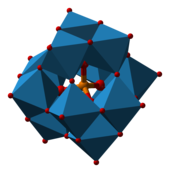User:Praseodymium-141/Molybdenum compounds
| Oxidation state |
Example[1][2] |
|---|---|
| -4 | Na 4[Mo(CO) 4] |
| −1 | Na 2[Mo 2(CO) 10] |
| 0 | Mo(CO) 6 |
| +1 | Na[C 6H 6Mo] |
| +2 | MoCl 2 |
| +3 | MoBr 3 |
| +4 | MoS 2 |
| +5 | MoCl 5 |
| +6 | MoF 6 |
Molybdenum compounds are compounds formed by the element molybdenum (Mo). Molybdenum forms chemical compounds in oxidation states -IV and from -II to +VI. Higher oxidation states are more relevant to its terrestrial occurrence and its biological roles, mid-level oxidation states are often associated with metal clusters, and very low oxidation states are typically associated with organomolybdenum compounds. Mo and W chemistry shows strong similarities. The relative rarity of molybdenum(III), for example, contrasts with the pervasiveness of the chromium(III) compounds. The highest oxidation state is seen in molybdenum(VI) oxide (MoO3), whereas the normal sulfur compound is molybdenum disulfide MoS2.[3]

From the perspective of commerce, the most important compounds are molybdenum disulfide (MoS
2) and molybdenum trioxide (MoO
3). The black disulfide is the main mineral. It is roasted in air to give the trioxide:[3]
- 2 MoS
2 + 7 O
2 → 2 MoO
3 + 4 SO
2
The trioxide, which is volatile at high temperatures, is the precursor to virtually all other Mo compounds as well as alloys. Molybdenum has several oxidation states, the most stable being +4 and +6 (bolded in the table at left).
Molybdenum(VI) oxide is soluble in strong alkaline water, forming molybdates (MoO42−). Molybdates are weaker oxidants than chromates. They tend to form structurally complex oxyanions by condensation at lower pH values, such as [Mo7O24]6− and [Mo8O26]4−. Polymolybdates can incorporate other ions, forming polyoxometalates.[4] The dark-blue phosphorus-containing heteropolymolybdate P[Mo12O40]3− is used for the spectroscopic detection of phosphorus.[5] The broad range of oxidation states of molybdenum is reflected in various molybdenum chlorides:[3]
- Molybdenum(II) chloride MoCl2, which exists as the hexamer Mo6Cl12 and the related dianion [Mo6Cl14]2-.
- Molybdenum(III) chloride MoCl3, a dark red solid, which converts to the anion trianionic complex [MoCl6]3-.
- Molybdenum(IV) chloride MoCl4, a black solid, which adopts a polymeric structure.
- Molybdenum(V) chloride MoCl5 dark green solid, which adopts a dimeric structure.
- Molybdenum(VI) chloride MoCl6 is a black solid, which is monomeric and slowly decomposes to MoCl5 and Cl2 at room temperature.[6]
Like chromium and some other transition metals, molybdenum forms quadruple bonds, such as in Mo2(CH3COO)4 and [Mo2Cl8]4−.[3][7] The Lewis acid properties of the butyrate and perfluorobutyrate dimers, Mo2(O2CR)4 and Rh2(O2CR) 4, have been reported.[8]
The oxidation state 0 and lower are possible with carbon monoxide as ligand, such as in molybdenum hexacarbonyl, Mo(CO)6.[3][9]
References[edit]
- ^ Schmidt, Max (1968). "VI. Nebengruppe". Anorganische Chemie II (in German). Wissenschaftsverlag. pp. 119–127.
- ^ Werner, Helmut (2008-12-16). Landmarks in Organo-Transition Metal Chemistry: A Personal View. Springer Science & Business Media. ISBN 978-0-387-09848-7.
- ^ a b c d e Holleman, Arnold F.; Wiberg, Egon; Wiberg, Nils (1985). Lehrbuch der Anorganischen Chemie (91–100 ed.). Walter de Gruyter. pp. 1096–1104. ISBN 978-3-11-007511-3.
- ^ Pope, Michael T.; Müller, Achim (1997). "Polyoxometalate Chemistry: An Old Field with New Dimensions in Several Disciplines". Angewandte Chemie International Edition. 30: 34–48. doi:10.1002/anie.199100341.
- ^ Nollet, Leo M. L., ed. (2000). Handbook of water analysis. New York, NY: Marcel Dekker. pp. 280–288. ISBN 978-0-8247-8433-1.
- ^ Tamadon, Farhad; Seppelt, Konrad (2013-01-07). "The Elusive Halides VCl 5 , MoCl 6 , and ReCl 6". Angewandte Chemie International Edition. 52 (2): 767–769. doi:10.1002/anie.201207552. PMID 23172658.
- ^ Walton, Richard A.; Fanwick, Phillip E.; Girolami, Gregory S.; Murillo, Carlos A.; Johnstone, Erik V. (2014). Girolami, Gregory S.; Sattelberger, Alfred P. (eds.). Inorganic Syntheses: Volume 36. John Wiley & Sons, Inc. pp. 78–81. doi:10.1002/9781118744994.ch16. ISBN 9781118744994.
- ^ Drago, R. S. , Long, J. R., and Cosmano, R. (1982) Comparison of the Coordination Chemistry and inductive Transfer through the Metal-Metal Bond in Adducts of Dirhodium and Dimolybdenum Carboxylates . Inorganic Chemistry 21, 2196-2201.
- ^ Werner, Helmut (2008-12-16). Landmarks in Organo-Transition Metal Chemistry: A Personal View. Springer Science & Business Media. ISBN 978-0-387-09848-7.
Category:Molybdenum Category:Molybdenum compounds Category:Chemical compounds by element
